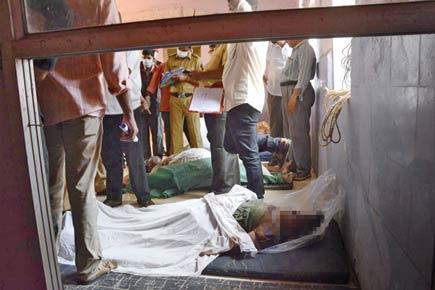In complete violation of the collector’s orders and the law, the Mahad hospital did not perform a single post-mortem but relied on less than thorough physical examinations

Apathy led to the tragic bridge collapse in Mahad, and it was on display yet again when the bodies of the victims began to wash up yesterday.
ADVERTISEMENT
Also read: 'Rude' Maharashtra minister gets flak for 'selfie' at collapsed Mahad bridge
 Not only did the hospital skip the post-mortem altogether, the doctor did not even bother to remove the victim’s clothes to check for injuries. Pic/Pradeep Dhivar
Not only did the hospital skip the post-mortem altogether, the doctor did not even bother to remove the victim’s clothes to check for injuries. Pic/Pradeep Dhivar
Despite a direct order from the district collector, insisting on a post-mortem for each and every victim, the rural body did not bother with a single autopsy and simply handed over the bodies to the next of kin. Instead, the doctor in charge claimed that they conducted physical examinations to determine the cause of death. As to how thorough this examination was – the doctor’s assistant confirmed that they did not even remove the clothes from the bodies to check for any injuries.
Also read - Mahad bridge collapse: Strong currents hamper op, only 14 bodies recovered
It’s true that in cases of mass casualties, the district administration and senior police officials have the power to certify bodies after conducting two or three sample post-mortems. In this case, however, not even the sample post-mortems were done. This is in direct violation of the law, since the deaths have now been registered under Section 174 of the CrPC, as confirmed by Inspector Vikram Jagtab, attached to Goregaon police station in Konkan range, who was at the MIDC Mahad police station.
Direct orders
Earlier in the day, Raigad District Collector Sheetal Ugale had told this reporter, “We insisted on post-mortems because we cannot be sure if all bodies are from the bridge mishap. In the monsoon, there are cases of drowning and it cannot be ruled out that some of the bodies might not be from the bridge collapse.”
Even Additional Superintendent of Police (Konkan range) Sanjaykumar Patil had said, “We do not want to take any chances, and therefore, have asked for post-mortem of all the bodies. Moreover, the authorities usually demand a copy of post-mortem report whie issuing compensation packages.”
But mid-day found that the ground reality was the complete opposite. The hospital has a small autopsy chamber in the backyard, but it remained locked through the day, even as the bodies were brought in one by one and kept at the hospital verandah.
Interestingly, a class IV employee from Poladpur rural hospital, Mothiram Nigade, was asked to report at Mahad to assist the in-charge, Dr BV Jaqtab, to conduct the post-mortems. However, he confirmed: “We could not perform post-mortem on a single body that was brought to us till evening. Some of the bodies were decomposed, the skin peeled off in some cases and some bodies were bloated. We did not even remove the clothes from their bodies. We handed over the bodies to their next of kin after the doctor certified their death.”
Also read: Bridge on Mumbai-Goa highway too old, UK government had warned state government in 2013
mid-day asked Dr BV Jaqtab – a practising general surgeon for 22 years – how he had certified the cause of death, and he said, it was done on the basis of physical examination. “We found froth and water coming out from their mouths, ears and nostrils, which is an indication of drowning,” said the doctor, also confirming that they did not perform any sample autopsies.
“I was given a verbal instruction to not do post-mortems by my superior, the civil surgeon,” he said, when this reporter asked him why he had flouted instructions from the collector and the police. Attempts made to contact district civil surgeon Dr Bahuballi Naigaonkar did not yield any results.
Meanwhile, some of the bodies are yet to be identified or claimed and preserving these bodies will be a challenge, since the Mahad hospital doesn’t have a mortuary or cold storage. The nearest hospital with such a facility is at Panvel. The in-charge, Dr Jagtab said, “We have made arrangements for ice to preserve the bodies. We will do a post-mortem and preserve viscera and DNA samples for identification.”
 Subscribe today by clicking the link and stay updated with the latest news!" Click here!
Subscribe today by clicking the link and stay updated with the latest news!" Click here!






